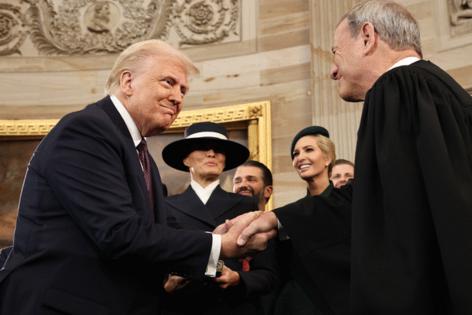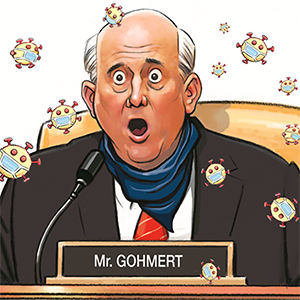Trump is winning in the Supreme Court because its conservatives believe in strong executive power
Published in News & Features
WASHINGTON — The Supreme Court signaled again this week that it believes the president has the full power to control federal agencies, including by sharply cutting their staffs and their spending.
It's the latest example of the court's conservative majority intervening to rule for President Donald Trump and against federal district judges. They have done so in brief orders with no explanation, prompting further criticism from Democrats and progressives.
But Chief Justice John G. Roberts Jr. and his conservative colleagues have made clear over many years that they believe the president's "executive power" includes controlling agencies and firing officials, even those who were deemed "independent" by Congress.
On Monday, the court issued a one-line order setting aside the decision of a federal judge in Boston who said the Education Department must rehire about 1,400 staffers who had been laid off.
Trump's attorneys had appealed in early June, arguing the administration was "streamlining" the department while "acknowledging that only Congress can eliminate" it.
Democratic state attorneys had sued to stop the layoffs, arguing Trump was effectively "dismantling" the department, and the judge agreed the layoffs were illegal.
The week before, the conservative majority set aside the decision of a federal judge in San Francisco who blocked Trump's plans for laying off tens of thousands of employees at more than 20 departments and agencies.
Democrats and progressives condemned the decisions and the majority's refusal to explain its reasons.
Michael Waldman, president of the Brennan Center, said the justices "have let Trump amass vast new power, and they have done so without putting their names on it. They are proving willing accomplices to a constitutional coup, all without leaving a trace."
In May, Roberts and the court upheld Trump's dismissal of Democratic appointees to the National Labor Relations Board and the Merit Systems Protection Board, both of whom had fixed terms set by Congress.
"Because the Constitution vests the executive power in the President, he may remove without cause executive officers who exercise that power on his behalf," the court said. "Both the NLRB and MSPB exercise considerable executive power."
The three liberals dissented.
Peter M. Shane, a New York University law professor, has written extensively on the so-called "unitary executive theory" and said it explains why Trump has been winning since he returned to the White House.
"Trump's use of executive power is not a distortion of the Roberts court's theory of the presidency," he said. "It is the court's theory of the presidency come to life."
Still pending before the court this week is an appeal from Trump's lawyers that seeks the firing of three Democratic appointees to the Consumer Product Safety Commission.
The commissioners have seven-year terms, but in May, the Trump White House told the three Democratic appointees they had been "terminated."
They sued and won a reinstatement order from a federal judge in Baltimore.
The recent rulings from the court have come on emergency appeals at the early stage of a lawsuit. The court's majority said Trump's initiatives may go into effect while the litigation continues. But at some point, the justices will have to hear arguments and issue a written ruling on the underlying legal issue.
In ruling for the three officials the CPSC, the judge in Baltimore pointed to the Supreme Court's 1935 decision which protected the constitutionality of "traditional multi-member independent agencies."
The court's opinion in the case of Humphrey's Executor vs. United States drew a distinction between "purely executive officers" who were under the president's control and those who served on a board "with quasi-judicial or quasi-legislative functions."
But that precedent has been endangered in recent years.
Five years ago, Roberts spoke for the court and ruled the director of the Consumer Finance Protection Bureau can be fired by the president, even though Congress had said otherwise.
But since that case did not involve a multi-member board or commission, it did not overrule the 1935 precedent.
_____
©2025 Los Angeles Times. Visit latimes.com. Distributed by Tribune Content Agency, LLC.







Comments